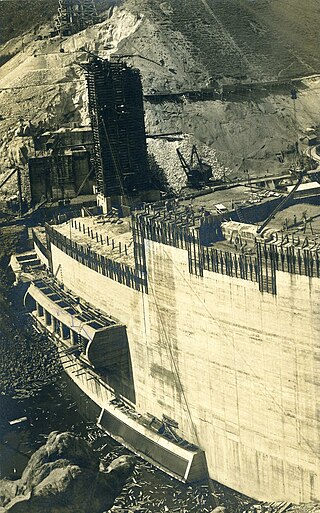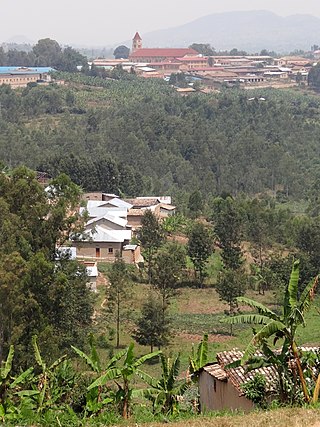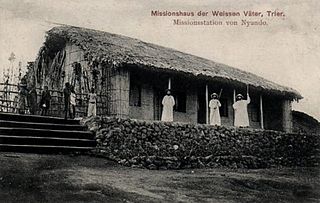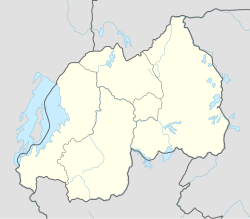
Rwanda, officially the Republic of Rwanda, is a landlocked country in the Great Rift Valley of East Africa, where the African Great Lakes region and Southeast Africa converge. Located a few degrees south of the Equator, Rwanda is bordered by Uganda, Tanzania, Burundi, and the Democratic Republic of the Congo. It is highly elevated, giving it the sobriquet "land of a thousand hills", with its geography dominated by mountains in the west and savanna to the southeast, with numerous lakes throughout the country. The climate is temperate to subtropical, with two rainy seasons and two dry seasons each year. It is the most densely populated mainland African country; among countries larger than 10,000 km2, it is the fifth-most densely populated country in the world. Its capital and largest city is Kigali.
Human occupation of Rwanda is thought to have begun shortly after the last ice age. By the 11th century, the inhabitants had organized into a number of kingdoms. In the 19th century, Mwami (king) Rwabugiri of the Kingdom of Rwanda conducted a decades-long process of military conquest and administrative consolidation that resulted in the kingdom coming to control most of what is now Rwanda. The colonial powers, Germany and Belgium, allied with the Rwandan court.
The Tutsi, also called Watusi, Watutsi or Abatutsi, are an ethnic group of the African Great Lakes region. They are a Bantu-speaking ethnic group and the second largest of three main ethnic groups in Rwanda and Burundi.

The Rwandan genocide, also known as the genocide against the Tutsi, occurred from 7 April to 19 July 1994 during the Rwandan Civil War. Over a span of around 100 days, members of the Tutsi ethnic group, as well as some moderate Hutu and Twa, were systematically killed by Hutu militias. While the Rwandan Constitution states that over 1 million people were killed, most scholarly estimates suggest between 500,000 and 662,000 Tutsi died. The genocide was marked by extreme violence, with victims often murdered by neighbors, and widespread sexual violence, with between 250,000 and 500,000 women raped.
Banyamulenge is a community that lives mainly in South Kivu province. The Banyamulenge are culturally and socially distinct from the Tutsi of South Kivu, with most speaking Kinyamulenge, a mix of Kinyarwanda, Kirundi, Ha language, and Swahili. Banyamulenge their role in Mobutu's war against and victory over the Simba Rebellion, which was supported by the majority of other tribes in South Kivu, their role during the First Congo War and subsequent regional conflicts (Rally for Congolese Democracy–Goma, Movement for the Liberation of the Congo, National Congress for the Defence of the People, and more importantly for the fact that two of the most influential presidents of their country declared them as enemy of the State both in 1996 and 1998.

Opération Turquoise was a French-led military operation in Rwanda in 1994 under the mandate of the United Nations. The "multilateral" force consisted of 2,500 troops, 32 from Senegal and the rest French. The equipment included 100 APCs, 10 helicopters, a battery of 120 mm mortars, 4 Jaguar fighter bombers, 8 Mirage fighters, and reconnaissance aircraft. The helicopters laid a trail of food, water and medicine enabling refugees to escape into eastern Zaire. Opération Turquoise is controversial for at least two reasons: accusations that it was an attempt to prop up the genocidal Hutu regime, and that its mandate undermined the UNAMIR. By facilitating 2 million Rwandan refugees to travel to Kivu provinces in Zaire, Turquoise setup the causes of the First Congo War.

The Kingdom of Rwanda was a Bantu kingdom in modern-day Rwanda, which grew to be ruled by a Tutsi monarchy. It was one of the oldest and the most centralized kingdoms in Central and East Africa. It was later annexed under German and Belgian colonial rule while retaining some of its autonomy. The Tutsi monarchy was abolished in 1961 after ethnic violence erupted between the Hutu and the Tutsi during the Rwandan Revolution which started in 1959. After a 1961 referendum, Rwanda became a Hutu-dominated republic and received its independence from Belgium in 1962.

The Murambi Technical School, now known as the Murambi Genocide Memorial Centre, is situated near the town of Murambi in southern Rwanda.

Rutshuru is a town located in the North Kivu province of the eastern Democratic Republic of the Congo, and is headquarters of an administrative district, the Rutshuru Territory. The town lies in the western branch of the Albertine Rift between Lakes Edward and Kivu. The Ugandan border is 15 km east and the Rwandan border is 30 km south-east. Lava flows from the Nyamuragira volcano, 40 km south-west, have come within 7 km of the town in recent years. The town has over 800,000 inhabitants from many tribal backgrounds mainly Hutu followed by Nande, hunde, Tutsi and Pygmee.

The Great Lakes refugee crisis is the common name for the situation beginning with the exodus in April 1994 of over two million Rwandans to neighboring countries of the Great Lakes region of Africa in the aftermath of the Rwandan genocide. Many of the refugees were Hutu fleeing the predominantly Tutsi Rwandan Patriotic Front (RPF), which had gained control of the country at the end of the genocide. However, the humanitarian relief effort was vastly compromised by the presence among the refugees of many of the Interahamwe and government officials who carried out the genocide, who used the refugee camps as bases to launch attacks against the new government led by Paul Kagame. The camps in Zaire became particularly politicized and militarized. The knowledge that humanitarian aid was being diverted to further the aims of the genocidaires led many humanitarian organizations to withdraw their assistance. The conflict escalated until the start of the First Congo War in 1996, when RPF-supported rebels invaded Zaire and sought to repatriate the refugees.

Kigeli IV Rwabugiri was the king (mwami) of the Kingdom of Rwanda in the mid-nineteenth century. He was among the last Nyiginya kings in a ruling dynasty that had traced its lineage back four centuries to Gihanga, the first 'historical' king of Rwanda whose exploits are celebrated in oral chronicles. He was a Tutsi with the birth name Sezisoni Rwabugiri. He was the first king in Rwanda's history to come into contact with Europeans. He established an army equipped with guns he obtained from Germans and prohibited most foreigners, especially Arabs, from entering his kingdom.

Islam is a minority religion in Rwanda, practiced by 2% of the total population according to the 2022 census. Virtually all Muslims in Rwanda are Sunni Muslim. Islam was first introduced into Rwanda by Muslim traders from the East Coast of Africa in the 20th century. Since its introduction, Muslims have been a minority in the territory, while Christianity, was introduced to Rwandans during the colonial period in the beginning of the 20th century, and is now the largest religion in the country.
Laurent Nkunda is a former General in the Armed Forces of the Democratic Republic of Congo (DRC) and is the former warlord operating in the province of North-Kivu, and a officer of the Tutsi-dominated government of neighbouring Rwanda. Nkunda, who is himself a Congolese born Tutsi, commanded the former DRC troops of the 81st and 83rd Brigades of the DRC Army. He speaks English, French, Swahili, Kinyarwanda, Lingala and Kinande. On January 22, 2009, he was put under house arrest in Gisenyi when he was called for a meeting to plan a joint operation between the Congolese and Rwandan militaries.

Sainte-Famille Church is a Catholic church in Muhima, downtown Kigali, in Rwanda. It is located on a hill, close to the cell of Rugenge. Sainte-Famille Church was the scene of killings during the genocide in April 1994.

Kabgayi is located just south of Gitarama in Muhanga District, Southern Province, Rwanda, 25 miles (40 km) southwest of Kigali. It was established as a Catholic Church mission in 1905. It became the center for the Roman Catholic Church in Rwanda and is the site of the oldest cathedral in the country and of Catholic seminaries, schools and a hospital. The church at first supported the Tutsi ruling elite, but later backed the Hutu majority. During the 1994 Rwandan genocide thousands of Tutsis who had taken refuge here were killed. Some survivors admire the courage of many priests who helped them during those difficult days, like Father Evergiste RUKEBESHA and many others. Later, some Hutus including three bishops and many priests were killed by the rebels RPF soldiers. A mass grave beside the hospital is marked by a memorial. Inside the Basilica are kept the bodies of the three bishops killed by FPR rebels. Two of them were refused by the Rwandan government to be transferred in their own cathedrals.

Archbishop André Perraudin, M. Afr. was a Swiss Catholic clergyman who lived in Rwanda for nearly fifty years. He was Archbishop of Kabgayi from 1959 to 1989.

Nyundo is a community in the Rubavu District of Western Province, Rwanda, on the Sebeya River to the east of Gisenyi. It is the location of one of the first Catholic missions to be established in Rwanda, and today is the headquarters of the Roman Catholic Diocese of Nyundo.
Bwakira is a former commune in western Rwanda. The main town was Birambo. In 1991 the population density was 343 people per square kilometer. During the Rwandan genocide the mayor (burgomaster) of Bwakira ordered mass killings and mass graves to be dug at Birambo.
During the Rwandan genocide of 1994, over the course of 100 days, up to half a million women and children were raped, sexually mutilated, or murdered. The International Criminal Tribunal for Rwanda (ICTR) handed down the first conviction for the use of rape as a weapon of war during the civil conflict, and, because the intent of the mass violence against Rwandan women and children was to destroy, in whole or in part, a particular ethnic group, it was the first time that mass rape during wartime was found to be an act of genocidal rape.
The double genocide theory posits that, during the Rwandan genocide, the Tutsi-led Rwandan Patriotic Front (RPF) engaged in a "counter-genocide" against the Hutus. Most scholars of Rwanda, such as Scott Straus and Gerald Caplan, say that RPF violence against Hutus does not fully match the definition of "genocide", considering that it instead consisted of war crimes or crimes against humanity.













